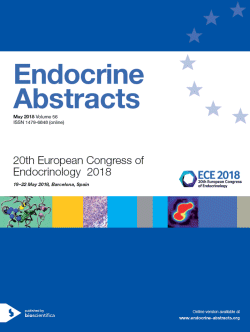
20th European Congress of Endocrinology
Barcelona,
Spain
19 May 2018 - 22 May 2018
Guided Posters
Acromegaly
ea0056gp2 | Acromegaly | ECE2018
Retinal vessel abnormalities in acromegaly
Fuchtbauer Laila , Olsson Daniel S , Norrman Lise-Lott , Bengtsson Bengt-AEke , Hellstrom Ann , Johannsson Gudmundur
ea0056gp3 | Acromegaly | ECE2018
An insight into the putative risk factors for IGF-1/GH dichotomy during follow-up for acromegaly
Seejore Khyatisha , Kyriakakis Nikolaos , Giannoudi Marilena , Lynch Julie , Orme Steve M , Barth Julian H , Murray Robert D
ea0056gp4 | Acromegaly | ECE2018
Efficacy and safety of switching to pasireotide LAR monotherapy or in combination with pegvisomant in acromegaly patients controlled with combination therapy of somatostatin analogues and pegvisomant (PAPE study): a prospective, open-label 48 week study
Coopmans Eva C , Muhammad Ammar , Janssen Joseph AMJL , van der Lely Aart J , Neggers Sebastian JCMM
ea0056gp5 | Acromegaly | ECE2018
The importance of MEN1 gene variants in AIP mutation negative FIPA patients
Yarman Sema , Tuncer Feyza Nur , Serbest Esin , Ogret Yeliz
ea0056gp6 | Acromegaly | ECE2018
IGF-I response to pasireotide LAR treatment in acromegaly is mainly driven by somatostatin receptor subtype 2 expression
Muhammad Ammar , Coopmans Eva , Gatto Federico , Franck Sanne , Janssen Joseph , van der Lelij Aart Jan , Hofland Leo , Neggers Sebastian
ea0056gp7 | Acromegaly | ECE2018
Familial cancer clustering in patients with pituitary adenoma
Djurdjevic Sandra Pekic , Soldatovic Ivan , Doknic Mirjana , Miljic Dragana , Stojanovic Marko , Petakov Milan , Popovic Vera
ea0056gp8 | Acromegaly | ECE2018
ACRONIS, a European observational study in patients with uncontrolled acromegaly who are being treated with long acting pasireotide: first interim analysis
Schofl Christof , Colao Annamaria , Neggers SJCMM , Feldt-Rasmussen Ulla , Moreno Eva Maria Venegas , Enderle Gesine , Mesenska Daniela , Andry Philippe , Tabarin Antoine
ea0056gp9 | Acromegaly | ECE2018
Pregnancy and acromegaly – clinical outcomes from the Irish Pituitary Network
Hannon Anne Marie , O'Shea Triona , Dineen Rosemary , Khattak Aftab , O'Halloran Domhnall , Hunter Steven , Sherlock Mark , Thompson Chris
ea0056gp10 | Acromegaly | ECE2018
Human growth hormone (GH) isoforms during oral glucose tolerance test in patients with acromegaly and in healthy subjects
Ulmer Esther , Schilbach Katharina , Haenelt Michael , Nicolay Shiva Sophia , Schwerdt Laura , Schweizer Junia Ribeiro de Oliveira Longo , Bartel Christopher , Schopohl Jochen , Strasburger Christian , Wu Zida , Bidlingmaier Martin
ea0056gp11 | Acromegaly | ECE2018
Observational, multicentre study to evaluate the effectiveness in routine clinical practice of Lanreotide Autogel 120 mg at extended dosing intervals (>4 weeks) for the treatment of acromegaly: SOMACROL study
Escola Cristina Alvarez , Fajardo Carmen , Marazuela Monica , Carballido Fernando Cordido , Venegas Eva Maria , Velasco Pedro de Pablos , Maroto Gonzalo Piedrola , Marquez Ma del Pilar Olvera , de Paz Isabel Pavon , Carvalho Davide , Romero Carme , De la Cruz Guillermo , Bernabeu Ignacio
ea0056gp12 | Acromegaly | ECE2018
Cumulative effects of growth hormone and insulin-like growth factor-1 exposure on cardiovascular, cerebrovascular and metabolic co-morbidities in acromegaly patients
Seejore Khyatisha , Kyriakakis Nikolaos , Giannoudi Marilena , Lynch Julie , Orme Steve M , Barth Julian H , Murray Robert D



